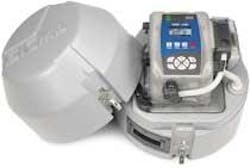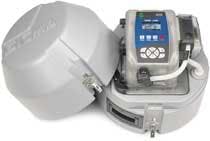Accurate Sampling Helps Ensure Proper IPP Reporting, Compliance
by Rachel Schneider
The Santa Rosa Industrial Waste Program in northern California serves an area of about 280 square miles that includes Santa Rosa, Rohnert Park, Sebastopol, Cotati, and the South Park Sanitation District. Incoming flow to the wastewater treatment plant during dry weather averages 16-17 mgd, depending on the application of water conservation programs. Between October and May, the plant is not typically allowed to discharge any effluent, so it must be recycled. To maintain a high-quality effluent for recycling purposes, industrial waste program personnel must strictly enforce regulations governing businesses that discharge wastewater into the Santa Rosa Subregional Water Reclamation System.
Because the subregional system regulates a low-water-supply area, meeting or exceeding discharge standards is critical. As one of the largest water recyclers in the world, the system supplies irrigation water to 6,400 acres of farmlands, vineyards, and landscaping sites. While most of the recycled water is directed towards agricultural uses, other projects also take advantage of the high-quality effluent. For example, the award-winning Calpine Geysers Recharge Project transports reclaimed water from Santa Rosa nearly 30 miles for injection into geothermal reservoirs. The heated water then provides steam to the geothermal electricity plants served by the geysers.
The Santa Rosa wastewater treatment plant uses a conventional activated sludge system, followed by anthracite filtration to remove colloidal materials. The final step is ultraviolet disinfection. This tertiary water treatment process leads to a very high quality effluent -- and this quality is dependent on the analysis and management of industrial waste streams feeding into the plant.
“We have a very unique system,” said Chris Murray, Environmental Compliance Inspector for the City of Santa Rosa Water Agency. “Not very many cities pump their effluent nearly 30 miles, including up a 3,000-foot hill, to inject it into steam beds.”
Source Control Program
This unique, fragile system must have a good source control program. Within the Santa Rosa Subregional Water Reclamation System, 35 significant industrial users have been identified, including metal finishers, food processors and semi-conductor plants. System inspectors must report to the EPA concerning these users on an annual basis. An additional 1,200-1,300 permit holders must also be monitored. These dischargers range from dry cleaners to printers to auto shops to car washes. Groundwater remediation sites are another waste stream source for the service area.
The wastewater treatment plant must be protected from toxics and particularly heavy metals. The data must be accurate and the means of sampling must be reliable. Monitoring is the only way that inspectors can determine whether dischargers are in compliance. In addition, discharge fees are adjusted based on the type and strength of each stream, which is determined by sample analysis. For example, there is a variable surcharge for biochemical oxygen demand and total suspended solids determined by loadings in pounds. This analysis is especially important for discharge from food processors and other facilities handling organics.
“We have two Environmental Compliance Inspectors I who perform the sampling and set up our monitoring stations at the significant industrial user sites,” Murray said. “These stations are typically set up with Hach Sigma automatic sampler systems, which will include either the old 800 model units or the newer 900 and 900-Max units.”
Murray said that flow-weighted samples are taken whenever possible, but most dischargers don’t discharge more than 2,000 gallons per day. “Three or four of our bigger industries are set up with Sigma 950 Bubbler Area Velocity Flowmeters, and there we perform flow-proportional sampling. But flows at most sites are too small to make this practical.”
Waste streams from the significant users are sampled typically every quarter, and sampling sessions run continuous for about one week at each location. Program management has determined that by monitoring for a full week, a valid picture of the process can be obtained.
Sampling Control
“We put a lot on the sampling program,” said Murray. “We want to have the best equipment because that is part of getting good sample results.”
To this end, personnel regularly test new equipment that may improve monitoring capabilities and help preserve Santa Rosa’s good track record for water conservation and reclamation. For example, the team recently participated in beta testing the new portable Hach Sigma SD900 Automatic Sampler Controller. The controller acts as the “brain” behind the sampling process and is designed to meet sampling requirements for industrial discharge, water and wastewater treatment, waste collection systems, stormwater, and rivers and streams.
The new SD900 sampler controller has passed the test with field personnel. The unit’s intuitive interface has shortened the learning curve for new users.
“The guys have been real happy with it,” Murray said. “It’s easy to set up, easier to see the screen, just easier to work with.”
The beta test included time-weighted sampling, collecting 100 ml every 15 minutes. The test applications were challenging in some cases. One test was set up at a local garbage hauler’s yard, where cans and bins are washed after use.
“They have a treatment system for the wash water,” Murray said, “but the discharges are intermittent and the location makes it difficult to get a good sample. The application lasted three days, and during that time the field technicians were able to pull good samples.”
The unit’s pump can draw a sample with up to 28 feet of suction head and can meet EPA specifications for maintaining a draw of two feet per second transport velocity with up to 25 feet of suction head.
“Most of the time we don’t have to go 28 feet,” Murray said, “but we have one application that’s pretty close to that length, and the SD900 unit seemed to work fine there.”
Adopting a best practice from nearby San Francisco, the staff replaces the sampler tubing after each use, rather than attempt acid cleaning. The new SD900 pump is designed with a hinged door and tubing guides so that tubing replacement takes only a few minutes. Their maintenance records reflect when the tubing is replaced on each sampler, which is especially important when sampling in a facility that generates metal-bearing waste streams.
“Tubing replacement completely eliminates the risk of sample contamination,” Murray said.
Where flow-weighted composite sampling is required, the automatic sampler controller can send the sample history to the flowmeter for recording. Later the recorded flow and discharge data can be downloaded to create a hydrograph that shows when the sampling points occurred.
The unit can retain up to three complete sampling programs in memory, controlling the sampler to gather the specified number and volume of samples at pre-set time intervals or based on flow.
Conclusion
Consistent sampling should represent both the regulator and the discharger, so that there are no differences between split samples.
“We increased our staff and installed brand new equipment in the 1990s,” said Murray. “But we want to keep up with new technology. Monitoring really determines compliance and you have to do it right. Without good sampling, you can get bogus data. That’s one of the reasons we try to get the best equipment.”
About the Author: Rachel Schneider is a samplers product manager with Hach Company (Loveland, CO). She can be reached at [email protected].

